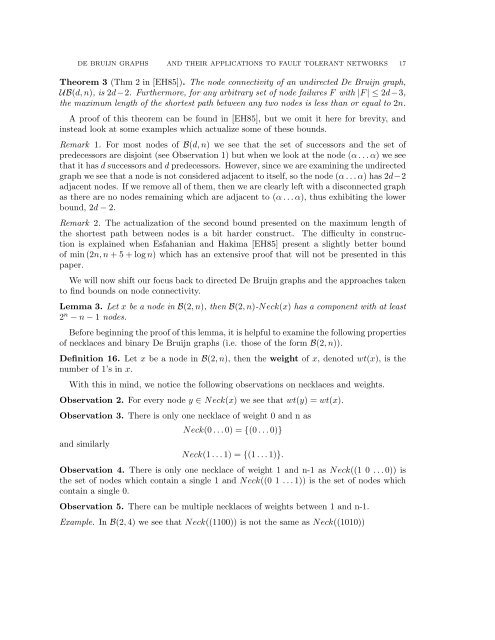De Bruijn Graphs and their Applications to Fault Tolerant Networks
De Bruijn Graphs and their Applications to Fault Tolerant Networks
De Bruijn Graphs and their Applications to Fault Tolerant Networks
Create successful ePaper yourself
Turn your PDF publications into a flip-book with our unique Google optimized e-Paper software.
DE BRUIJN GRAPHS AND THEIR APPLICATIONS TO FAULT TOLERANT NETWORKS 17Theorem 3 (Thm 2 in [EH85]). The node connectivity of an undirected <strong>De</strong> <strong>Bruijn</strong> graph,UB(d, n), is 2d−2. Furthermore, for any arbitrary set of node failures F with |F | ≤ 2d−3,the maximum length of the shortest path between any two nodes is less than or equal <strong>to</strong> 2n.A proof of this theorem can be found in [EH85], but we omit it here for brevity, <strong>and</strong>instead look at some examples which actualize some of these bounds.Remark 1. For most nodes of B(d, n) we see that the set of successors <strong>and</strong> the set ofpredecessors are disjoint (see Observation 1) but when we look at the node (α . . . α) we seethat it has d successors <strong>and</strong> d predecessors. However, since we are examining the undirectedgraph we see that a node is not considered adjacent <strong>to</strong> itself, so the node (α . . . α) has 2d−2adjacent nodes. If we remove all of them, then we are clearly left with a disconnected graphas there are no nodes remaining which are adjacent <strong>to</strong> (α . . . α), thus exhibiting the lowerbound, 2d − 2.Remark 2. The actualization of the second bound presented on the maximum length ofthe shortest path between nodes is a bit harder construct. The difficulty in constructionis explained when Esfahanian <strong>and</strong> Hakima [EH85] present a slightly better boundof min (2n, n + 5 + log n) which has an extensive proof that will not be presented in thispaper.We will now shift our focus back <strong>to</strong> directed <strong>De</strong> <strong>Bruijn</strong> graphs <strong>and</strong> the approaches taken<strong>to</strong> find bounds on node connectivity.Lemma 3. Let x be a node in B(2, n), then B(2, n)-Neck(x) has a component with at least2 n − n − 1 nodes.Before beginning the proof of this lemma, it is helpful <strong>to</strong> examine the following propertiesof necklaces <strong>and</strong> binary <strong>De</strong> <strong>Bruijn</strong> graphs (i.e. those of the form B(2, n)).<strong>De</strong>finition 16. Let x be a node in B(2, n), then the weight of x, denoted wt(x), is thenumber of 1’s in x.With this in mind, we notice the following observations on necklaces <strong>and</strong> weights.Observation 2. For every node y ∈ Neck(x) we see that wt(y) = wt(x).Observation 3. There is only one necklace of weight 0 <strong>and</strong> n as<strong>and</strong> similarlyNeck(0 . . . 0) = {(0 . . . 0)}Neck(1 . . . 1) = {(1 . . . 1)}.Observation 4. There is only one necklace of weight 1 <strong>and</strong> n-1 as Neck((1 0 . . . 0)) isthe set of nodes which contain a single 1 <strong>and</strong> Neck((0 1 . . . 1)) is the set of nodes whichcontain a single 0.Observation 5. There can be multiple necklaces of weights between 1 <strong>and</strong> n-1.Example. In B(2, 4) we see that Neck((1100)) is not the same as Neck((1010))
















